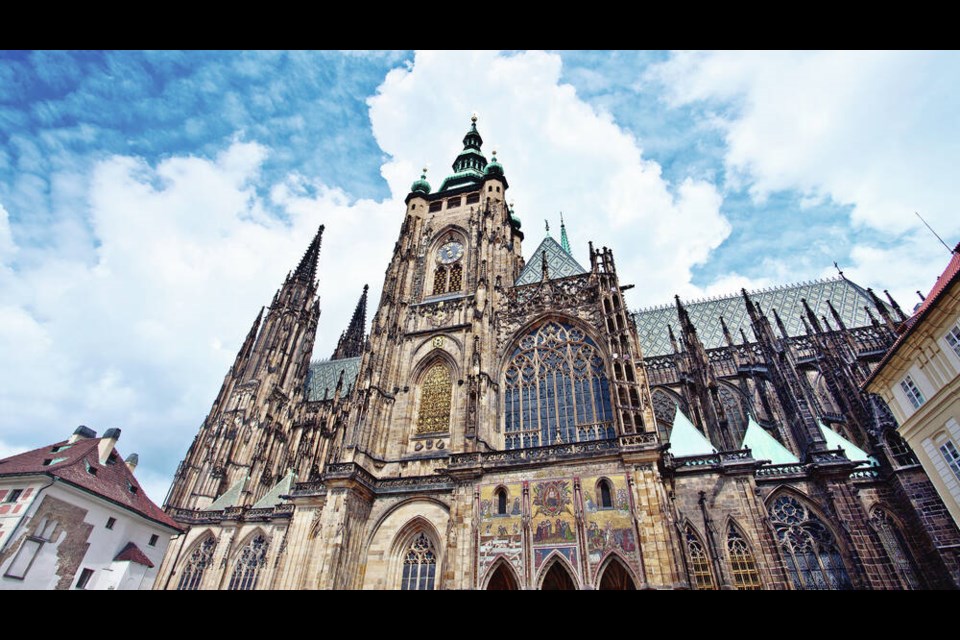Prague is one of Europe’s best-preserved cities, having been spared from last century’s bombs. Nowhere is this more evident than in the hilltop Castle Quarter, which looms above the city and dominates the skyline. Filled with high art and grand buildings from the past 1,200 years, this area is packed with history. Even today, you feel like clip-clopping through these streets in a fancy carriage.
Dominating the neighbourhood is Prague Castle. Czech leaders have ruled from here for more than a thousand years. The castle is hailed as the biggest anywhere, with a 1,500-foot-long series of courtyards, churches, and palaces. If exhausting is a measure of big, I’ll buy that claim. On one memorable visit to the castle, I felt as if I were in a pinball machine — rolling downhill, bouncing from sight to sight before funnelling out the lower gate.
My first stop was St. Vitus Cathedral, the most important church in the Czech Republic — and the most crowded part of the castle complex. The centrepiece of the cathedral is Alphonse Mucha’s masterful 1931 Art Nouveau window depicting the saints Methodius and Cyril, widely considered the fathers of Slavic-style Christianity.
The cathedral is also home to the tombs of royal and religious VIPs, such as Ferdinand I, the first Habsburg emperor and St. John of Nepomuk, a national saint whose tomb boasts more than a ton of silver. Because of the church’s proximity to the royals’ home, the king had his own boxed pew in a private balcony — connected by an elevated corridor to his private apartment so that he could attend Mass in his jammies.
The historic heart of the church is the fancy Wenceslas Chapel. It contains the tomb of St. Wenceslas, patron saint of the Czech nation (and the “Good King” of Christmas carol fame), who united the Czech people back in the 10th century. A rare example of a well-educated and literate ruler, he lifted the culture, astutely allied the powerless Czechs with the Holy Roman Empire, and began to fortify Prague’s castle as a centre of Czech government. For centuries, Czech kings were crowned right in front of Wenceslas’s red-draped coffin. The new king was handed a royal scepter, orb, and sword, and fitted with the jewelled St. Wenceslas crown. Wenceslas’s story may be more legend than history, but he remains an icon of Czech unity whenever the nation has to rally.
After crossing the square, I visited the Old Royal Palace, seat of Bohemian princes since the 12th century. Back in the day, the palace’s large hall was filled with market stalls, giving nobles a chance to shop without actually going into town. The space was even big enough for jousts, with a staircase that was designed to let a mounted soldier gallop in. Until the late 1990s, this is where parliament gathered to elect the president.
This palace was also the site of the world’s most famous political defenestration — a literal one. When two regional governors for the Catholic Habsburgs clamped down on religious freedom in 1618, angry Czech Protestant nobles poured into their office and threw the two governors out the window (fenestra, in Latin). The two survived, but the incident kicked off the devastating Thirty Years’ War — and gave us a term for getting rid of bad politicians.
Finally reaching the bottom of the castle complex, I wandered into Lobkowicz Palace, which displays the private collection of a prominent Czech noble family, including paintings, ceramics, and musical scores.
A highlight is the fabulous audioguide, narrated by members of the Lobkowicz family — including the prince of the palace himself, William Lobkowicz. Formerly a Boston real-estate broker, William returned here in 1990 to reclaim his family’s properties and eventually restore them to their former state. The audioguide brings the place to life and lets you get to know the family — who lost all their possessions to the Nazis, got them back after the Second World War, and then lost them all again to the communists.
After turning in the audioguide, I gave the clerk my business card and told her to thank the prince. She asked me if I’d like to meet him. So William and his wife Sandra ended up taking me through the palace for a more intimate peek at things. We talked about post-Nazi restitution challenges and triumphs, and the fact that many nobles have gotten a bad rap since the French Revolution. As William put it, “We’re just real people who own lots of big palaces.” On reflection, I decided “noble” might now best describe the effort William and his family are making to preserve valuable pieces of the Czech cultural heritage.
This article is used with the permission of . Rick Steves writes European guidebooks, hosts travel shows on public TV and radio, and organizes European tours.



